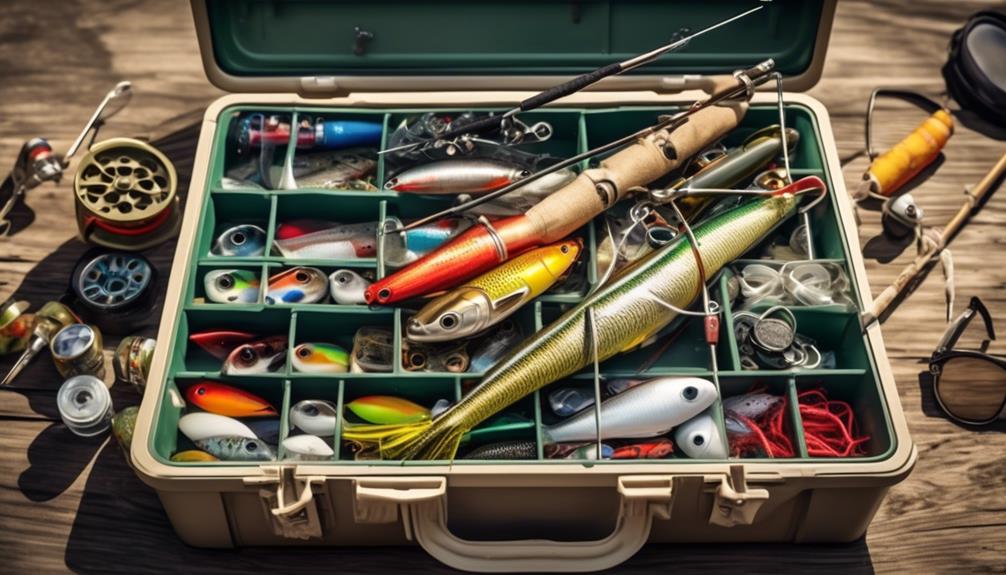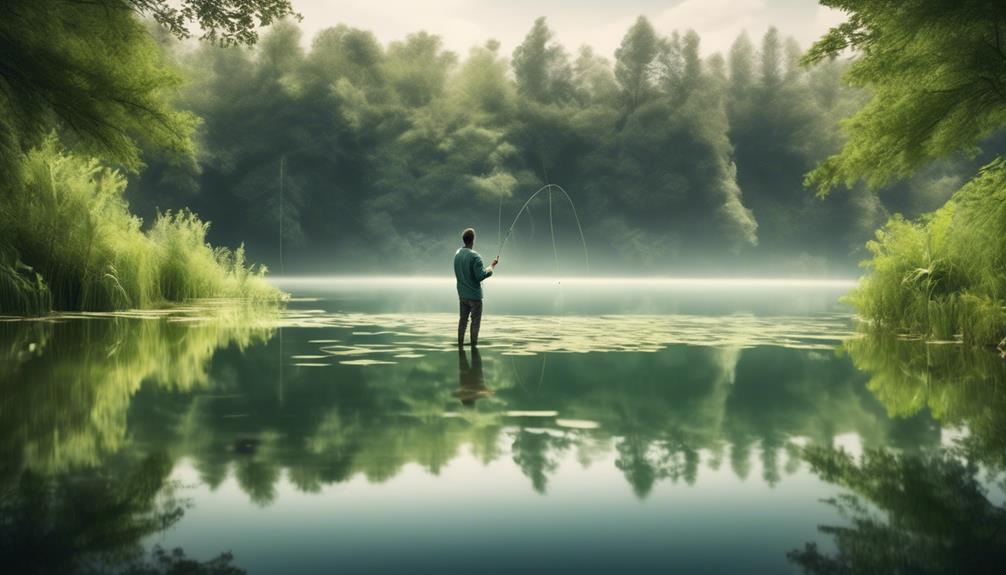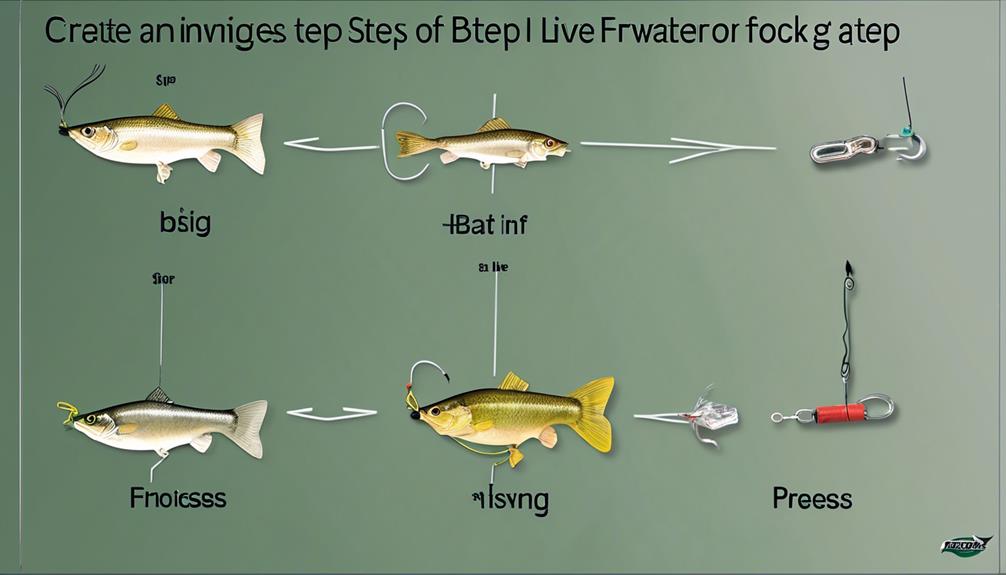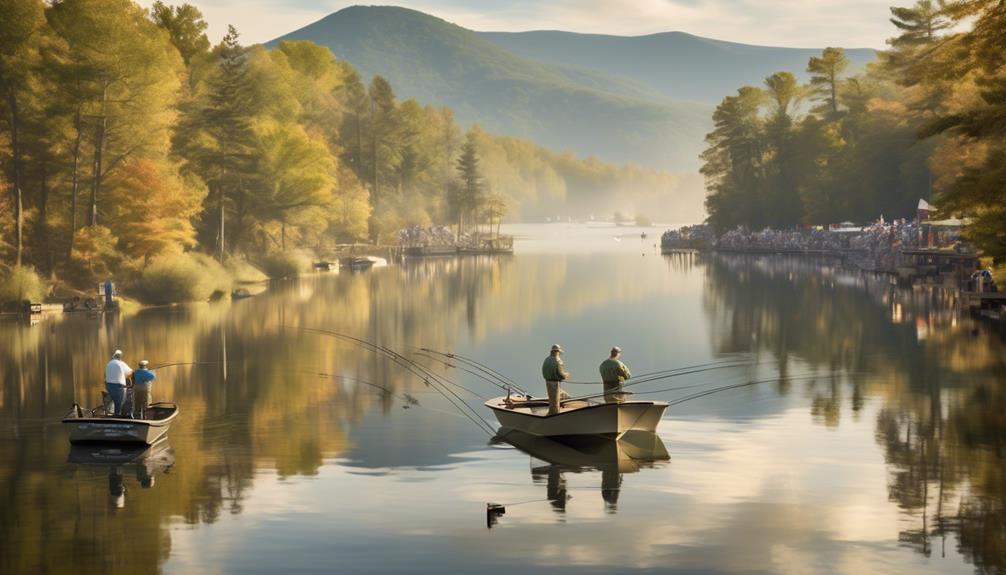Imagine yourself standing at the edge of a tranquil freshwater lake, the sun just beginning to rise, and the gentle ripples on the water promising a day of fruitful fishing ahead.
As you prepare to embark on this serene adventure, you realize the importance of having the right equipment at your disposal. Whether you're a seasoned angler or just starting out, knowing the essential gear for freshwater fishing is key to a successful and enjoyable experience.
But where do you begin? Follow along as we uncover the twelve must-have pieces of equipment that will elevate your freshwater fishing game to new heights.
Rods and Reels
When selecting rods and reels for freshwater fishing, prioritize lightweight, durable equipment that matches the type of fish you intend to catch. Proper maintenance is crucial for keeping your rods and reels in top condition. After each use, rinse them with fresh water to remove any salt or dirt that could cause damage. Wipe them down with a cloth and apply a light coat of oil to prevent rust.
As for the best brands, popular choices include Shimano, Daiwa, and Abu Garcia. These brands are known for producing high-quality, reliable equipment that will enhance your fishing experience.
Casting techniques are essential for successful freshwater fishing. Practice different casting methods to improve your accuracy and distance. One technique to master is the overhead cast, where you bring the rod backward, then smoothly propel it forward, releasing the line at the right moment.
Another important aspect is choosing the right size of rod and reel. Match the size to the type of fish you're targeting. For smaller fish, a lighter, more flexible rod is suitable, while larger fish require a sturdier, heavier setup.
Fishing Line
Select a high-quality fishing line that matches the weight and behavior of your target fish to improve your chances of a successful freshwater fishing experience. Line strength and durability are crucial factors to consider when choosing a fishing line. Different fish species have varying strength and behavior, so it's essential to match the line strength to the type of fish you're targeting.
For instance, if you're going after larger, stronger fish, such as bass or pike, opt for a heavy-duty line with a higher pound test rating to withstand their powerful runs and aggressive fighting. On the other hand, if you're targeting smaller fish like trout, a lighter line would be more appropriate.
Furthermore, mastering the art of knot tying is imperative for securing your bait or lures to the fishing line. Ensure that you learn how to tie strong and reliable knots such as the improved clinch knot, palomar knot, and double uni knot.
Regular line maintenance is also essential for prolonging the life of your fishing line. Check for any signs of wear and tear, such as nicks or frays, and replace the line if necessary. Additionally, clean your fishing line after each use to remove any dirt, debris, or fish slime that could weaken the line over time.
Investing in a quality fishing line and dedicating time to learn proper knot tying and line maintenance techniques will significantly enhance your freshwater fishing endeavors.
Hooks and Baits
To maximize your chances of a successful freshwater fishing outing, choosing the right hooks and baits tailored to your target fish is crucial. Bait selection and hook sizes play a significant role in determining your fishing success. Here are some essential tips to help you make the best choices:
- Bait Selection: Different fish species have varying preferences when it comes to bait. Research the specific species you're targeting to understand their feeding habits. For example, if you're aiming to catch catfish, using baits such as chicken livers, nightcrawlers, or stinkbaits can be highly effective. On the other hand, bass may be more enticed by artificial lures that mimic small fish or insects. Understanding the preferences of your target fish will significantly increase your chances of a successful catch.
- Hook Sizes: Matching the hook size to the bait and the fish you're targeting is crucial. Using a hook that's too large can deter smaller fish from biting, while a hook that's too small may not be able to effectively hook larger fish. Additionally, consider the specific fishing technique you plan to use, as this can also affect the ideal hook size. For instance, when using live bait, such as worms or minnows, smaller hooks are generally more effective, while larger hooks are suitable for artificial lures or chunk baits.
Tackle Box
Now that you have your hooks and baits sorted out, the next essential item to have for your freshwater fishing adventure is a well-stocked tackle box. Tackle organization is key to ensuring that you have everything you need for a successful fishing trip.
When organizing your tackle box, it's important to arrange your items in a logical manner. Keep frequently used items such as hooks, weights, and bobbers in easily accessible compartments. Sort your lures by type and size to make it easier to find the right one when you need it. Additionally, consider using small containers or dividers to keep everything neatly separated.
Tackle maintenance is also crucial for ensuring that your equipment remains in good condition. After each fishing trip, take the time to clean your tackle box and remove any dirt, debris, or rust from your tools and lures. This will help prevent corrosion and extend the lifespan of your gear. Inspect your hooks and lures for any signs of damage and replace or repair them as needed.
Keeping your tackle box well-maintained will save you time and frustration when you're out on the water.
Fishing Lures
When selecting fishing lures for freshwater fishing, consider the natural prey of the fish in your target area. Lure selection plays a crucial role in enticing fish to bite. Different types of lures mimic specific prey, so understanding the local ecosystem is essential for success.
Once you've chosen the right lures, it's equally important to master lure presentation. How you maneuver the lure in the water can make all the difference in attracting fish. Here are three key factors to consider:
- Matching the Hatch: Research the natural forage in the area where you'll be fishing. Match your lure selection to the prevalent baitfish and insects. If your target fish commonly feeds on minnows, using a lure that imitates a minnow will increase your chances of a successful catch.
- Color and Size: Pay attention to the color and size of the lures. Different water conditions and times of day may call for specific colors and sizes. For example, in clear water, natural and realistic colors tend to work best, while in murky water, brighter colors can be more effective.
- Lure Action: Understanding how to present the lure with the right action is crucial. Some lures are meant to be retrieved quickly with lots of movement, while others require a more subtle and slow presentation. Experimenting with different retrieval techniques can help you figure out what works best for the fish you're targeting.
Mastering lure selection and presentation can significantly improve your freshwater fishing results.
Fishing Nets
Consider the size and mesh type of your fishing net to ensure it's suitable for the species and environment in which you'll be fishing.
When choosing a fishing net, it's crucial to select the right size and material. The net size should be appropriate for the fish you aim to catch and the environment in which you'll be fishing. A larger net may be suitable for catching bigger fish, while a smaller net with a finer mesh might be more suitable for catching smaller fish or fishing in areas with dense vegetation or obstacles. Additionally, the material of the net should be durable and resistant to wear and tear, especially if you'll be fishing in rough terrain or catching larger, stronger fish.
Proper maintenance and techniques are essential for ensuring that your fishing net remains in good condition and continues to be effective. After each use, rinse the net with clean water to remove any debris or residue. Allow it to air dry thoroughly to prevent the growth of mold or mildew. Periodically inspect the net for any signs of damage, such as tears or weakened areas, and mend them promptly to prevent further deterioration.
Fishing Tools
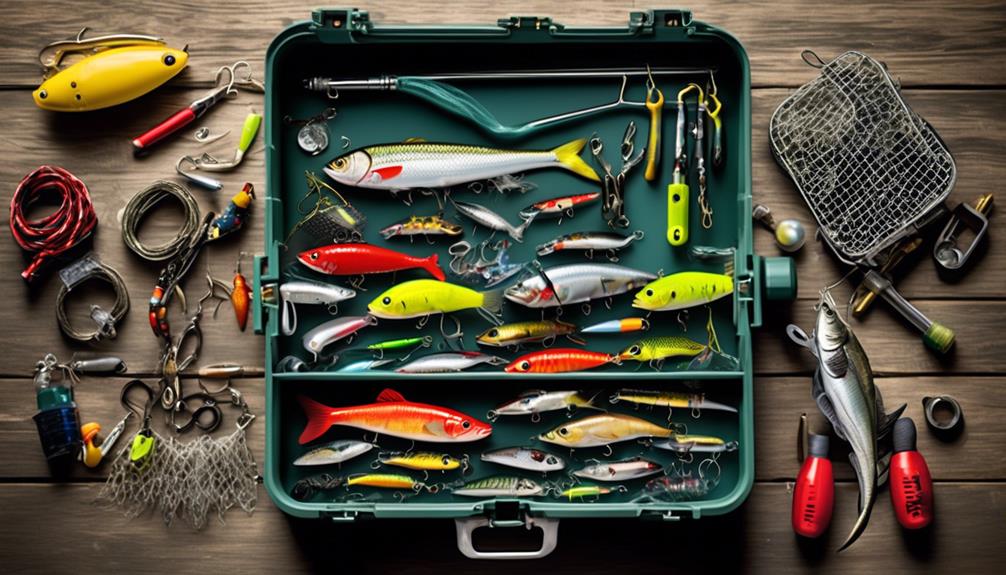
To effectively maintain and utilize your fishing tools, it's crucial to continue the same level of care and attention that you give to your fishing nets, ensuring they remain in optimal condition for your fishing ventures. Proper maintenance and understanding of fishing tools are essential for a successful fishing experience. Here are some key points to consider:
- Fishing Knots and Techniques: Mastering various fishing knots and techniques is vital for success. Different fish species may require specific knots to ensure a secure and reliable hold. Understanding the right knots and techniques for different fishing situations will greatly enhance your efficiency and success on the water.
- Fish Species and Habitat: Knowing the fish species you're targeting and their habitat is crucial for selecting the right fishing tools. Different fish species have unique behaviors and habitats, which may require specific tools for a successful catch. Understanding the behavior and habitat of the fish you're targeting will allow you to select the appropriate tools, giving you a better chance of a successful fishing trip.
- Tool Maintenance: Regularly cleaning and maintaining your fishing tools is essential for their longevity and performance. Properly maintained tools ensure they function effectively when needed and can prevent potential malfunctions that could cost you a catch. Regularly inspecting and maintaining your tools won't only extend their lifespan but also contribute to a more enjoyable fishing experience.
Fishing Apparel
Proper attire is crucial for comfort and protection during your freshwater fishing expeditions. When it comes to fishing apparel, there are a few key pieces that can greatly enhance your experience on the water.
Breathable waders are essential for keeping you dry and comfortable while wading in rivers or streams. Look for waders with reinforced knees and neoprene feet for durability and traction. Pair these with waterproof jackets to shield yourself from the elements, ensuring that sudden rain showers won't dampen your fishing trip.
In addition to outerwear, UV protective shirts are a must-have to shield your skin from the sun's harmful rays. These shirts are designed to offer maximum sun protection, making them perfect for long days spent fishing under the sun. Quick dry pants are also a valuable addition to your fishing wardrobe, especially when you anticipate getting wet or encountering rainy conditions. These pants are designed to repel moisture and dry rapidly, keeping you comfortable throughout your fishing adventure.
Investing in high-quality fishing apparel not only ensures your comfort and protection but also contributes to a more enjoyable and successful fishing experience. By prioritizing breathable waders, waterproof jackets, UV protective shirts, and quick dry pants, you can focus on the thrill of fishing without being hindered by discomfort or exposure to the elements.
Frequently Asked Questions
What Are the Best Types of Live Bait to Use for Freshwater Fishing?
For freshwater fishing, the best live bait options depend on the fish species and conditions. Worms, minnows, and insects are popular choices. Live bait can entice more bites, but artificial lures offer versatility and less mess.
How Should I Properly Clean and Maintain My Fishing Net?
To properly maintain your fishing net, rinse it thoroughly with fresh water after each use. Hang it to dry completely before storing to prevent mildew. If needed, use a mild detergent and gentle scrubbing to remove debris.
Are There Any Specific Tools or Accessories That Can Help With Removing a Fish Hook?
When removing a fish hook, always prioritize safety precautions. Use tools like long-nose pliers or a hook remover for a smooth extraction. Avoid jerking the hook, and consider wearing gloves for added protection.
What Type of Apparel Is Best for Fishing in Different Weather Conditions?
When fishing in different weather conditions, layering clothing is key. Bring rain gear for wet days, sun protection for sunny days, and cold weather gear for chilly days. Dressing appropriately will ensure a comfortable fishing experience.
Can You Provide Tips for Effectively Using Fishing Lures in Freshwater Environments?
When fishing in freshwater, choose lures based on the type of fish you're targeting. Vary your presentation to mimic natural movements. Experiment with different techniques like jigging, twitching, and retrieving to find what works best.
Conclusion
So there you have it, the 12 essential equipment pieces for freshwater fishing.
With the right rods, reels, line, hooks, baits, tackle box, lures, nets, tools, and apparel, you'll be fully equipped to enjoy a successful day out on the water.
Make sure to pack these items before your next fishing trip and you'll be ready to reel in some big catches.
Happy fishing!
